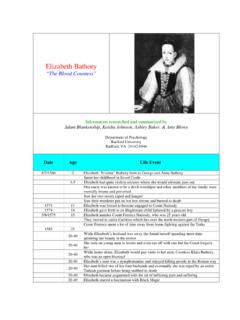Transcription of ELIZABETH OF THE TRINITY (Elizabeth Catez, 1880 …
1 ELIZABETH OF THE TRINITY ( ELIZABETH Catez, 1880-1906) Servant of God (D) Born in .the military camp of Arvor, near Bourges, on Aug. 18, 1880, ELIZABETH enjoyed an adolescence and young womanhood filled with the sense of God and with zeal for the salvation of souls. While still an adolescent, she made a vow of chastity and offered herself as a victim to God for France. In 1901 she entered the Carmel at Dijon, to which her family had transferred. On Dec. 8 of the same year she received the habit and on Jan. 11, 1903, she made her profession. Struck by a stomach ulcer, she died on Nov. 9, 1906. The ordinary processes were held during the years 1931-41. On Jan. 28, 1944, her writings were approved, and on Oct. 25, 1961, Pope John XXIII approved the commission for the introduction of her cause (AAS, LVI /1964/, pp. 535-37). The apostolic processes took place from 1963 till 1965. The servant of God is one of the best-known figures of contemporary spirituality. By her example and by her doctrine she has for some years exercised an ever-increasing influence, due above all to her experience of the TRINITY and to her brief writings (spiritual notes, correspondence).
2 The writings are heavily doctrinal and echo her communion with the three Divine Persons. Humble and pure, enriched with an intelligence open to all the beauties of grace, of nature and of art, she learned the lesson of love for the Three according to a favorite expression of hers in the school of St. Paul, of St. Teresa of Avila and of St. John of the Cross. At the same time she learned the laws of correspondence with such love. Silence and recollection, an enlightened contemplation of the mystery of the TRINITY and of Christological dogma, a generous docility to the least inspirations, unconditional fidelity to the divine will in her Carmelite vocation all formed her to such a life of surrender that in a short time she reached high perfection. Clinging to the soul of Christ, her favorite book, in Him and with Him she rose to the TRINITY , Whose praise of glory she wished to be, that is, a soul that always adores and, so to speak, is wholly transformed into praise and love, in its passion for the glory of its God.
3 Such praise and such love were directed essentially to the three Divine Persons present in her soul; this is the center of her spirituality and of her message. In fact, she wrote: I am ELIZABETH of the TRINITY , that is, ELIZABETH who disappears, who is lost, who lets herself by invaded by the Three. And she added: Love dwells within us; therefore my only exercise is to enter into my interior and to lose myself in Those Who are there. The happiness of my life is my intimacy with the Guests of my soul. This spiritual orientation, founded on her conviction of faith in the divine indwelling, was the grace of her life. Most faithful to the progressive interior illumination that came to her above all, by her contemplative probing of the texts of the Gospel and of St. Paul she was able to arrive at noteworthy experiences like that of the feast of the Ascension in 1906: This morning I heard in the depth of my soul this word, 'If anyone love Me, ..My Father will love him, and We will come to him and will make our abode with him' (Jn.)
4 14: 23), and in the same instant I saw how that really happened. I would not know how the three Divine Persons revealed Themselves, but still I saw Them holding within me Their council of love; and it seems to me that I still see Them thus. The grace of an almost uninterrupted awarensess of the indwelling of the TRINITY accompanied her during the last months of her life. It strengthened and sustained her in the period of martyrdom which was to configure her to the death of Jesus, transform her into Him crucified for the glory of the Father and for the Church. Already on Nov. 21, 1904, in her famous Elevation to the TRINITY , O my God, the TRINITY Whom I adore, she had asked of the Holy Spirit: Come down into me, so that, as it were, another incarnation of the Word may take place in my soul: that I may become a humanity added to Him (une humanit de surcrolt) in which He may renew His mystery. Yet she knew that such an aspiration could not be realized except on the cross. God heard her.
5 The year 1906 was a succession of sufferings borne with fortitude in union with Christ, with her gaze turned to the Church and to souls. After one violent crisis she was heard to exclaim: 0 Love, Love! Consume all my substance for Your glory! That it may be distilled drop by drop for Your Church! This was the ideal which sustained her and which made her write to her mother: The Father has predestined me to be conformed to His crucified Son. My Bridegroom wishes me to be an added humanity in which He can still suffer for the glory of the Father and to help the Church. This thought does me so much good. He has chosen your daughter to associate her with the great work of redemption; He has signed her with the seal of the cross, and on the cross she suffers as an extension of the passion. Enlivened by such certainties, sustained by an ever more lively and theological love for the Immaculate Virgin the Gate of heaven and the great Praise of Glory of the TRINITY , as she described Our Lady and, even while suffering, rejoicing in the intimacy of the Three , ELIZABETH died, murmuring, almost singing: I go to light, to love, to life!
6 She had written some time before: The TRINITY ! Behold our abode, our domestic hearth, our paternal home which we must never leave! And two weeks before her death: I believe that in heaven my mission will be to attract souls to interior recollection, helping them to get outside themselves in order to cling to God with a very simple and altogether loving movement, and maintaining them in that great interior silence which permits God to imprint Himself in them and to transform them into Himself. Her invitation and her promise have not remained dead letters: many souls, as the documentation collected for the opening of the cause of beatification proves, follow her way and her example in reliving her grace, the fully baptismal grace which configures to Christ and fixes in the depths of our being the loving presence of the TRINITY , the source and end of all perfection. WRITINGS. The writings of Sister ELIZABETH of the TRINITY have not yet been wholly published in the French original.
7 Some texts have appeared as an appendix to Souvenirs (see below), even in the first edition. Almost immediately too were published the Reflexions et pens es sous forme de retraite, at first partially, then (1942) in a complete edition. (A new edition, with a docrinal preface of Father John-Peter of the TRINITY , appeared at Dijon in 1968.) Meanwhile M. M. Philipon was providing for the press the writings more noteworthy for their spiritual value: Ecrits spirituels: lettres, retraites, in dits, Paris, 1949; 3rd edit. 1962; Ital vers. Scritti spirituali di Sr. E. d. T., Brescia, 1950; 2nd edit., 1981. There is also an edition in English. The Obras Completas of E., published at Madrid in 1958 by the Ed. de Espiritualidad, are in reality only the collection of these writings, joined to those already known from the Souvenirs, of which a new edition had also been published, together with a commentary of E. Vandeur, O. S. B., on the Trinitarian Elevation. A complete edition of all the writings of ELIZABETH that had been gathered together for the canonical examination of the cause of beatification appeared in Italian: Serva di Dio Suor E.
8 D. T., carmel. sc, Scritti , Rome, 1987, published by the Postulator Gen., O. C. D., in the version of Dante Giovannini, with a noteworthy introduction by Benvenuto Matteucci. A little later, there appeared a more complete Spanish edition of the Obras completas of the Servant of God (Burgos, 1969), edited by Alfonse Aparicio, O. C. D., and including some unedited writings; this edition was prepared at Dijon and based on the autographs and authentic copies. Everyone is hoping for an original French edition. BIBLIOGRAPHY: The most important work on ELIZABETH of the TRINITY remains the book entitled: Souvenirs de Soeur E. de la T. (1st edit. Dijon 1915; new edit. ibid. 1956), composed by M. Germana of Jesus (+1934). who had been mistress of novices and prioress of ELIZABETH and her principal spiritual director. Translated into the more important world languages (oriental as well) the Italian version has had six editions; Suor E. d. T., Ricordi, Florence 1955. Also to be mentioned are: Positio super causae introductione, Rome 1956, and the Articles pour le procee apostolique, ibid.
9 1962; M. M. Philipon, La doctrine spirituelle de Soeur Elisabeth de la Tr., Paris-Bruges 1939 (vers. it. La dottrina spirituale di Sr. E. d. T. S" ed., Brescia 1968); Marie-Amabel du Coeur de Jesus, A la lumiere, a l'amour, a la vie, Paris-Bruges 1933 (vers. it. Verso la luce, I'amore, la vita, 4 ed., Milano 1948); Hans Urs von Balthasar, Elisabeth von Dijon und ihre geistliche Sendung Cologne e Olten 1952 (vers. it. Suor E. d. T. e il suo messaggio spirituale, Milan-Rome 1959); recently this work has been revised and edited anew by the same author, together with an essay on Therese of Lisieux: Schwestern in Geist: Therese von Lisieux und Elisabeth von Dijon, Einsiedeln 1970; Ho creduto nella divina presenza: a special number of the Rivista di vita spirituale on the fiftieth anniversary of the death of the Servant of God, Rome 1956 (on pp. 155-68, a critical Bibliographical survey); Lafrance Jean, Apprendre a prier avec Sr. Elisabeth de la Trinit , Paris 1964; M. M. Philipon, En Pr sence de Dieu E.
10 De la T., Paris-Bruges 1966 (vers. it. L'inabitazione della Trinit nell'anima. La spiritualit di E. d. T., Milan 1966: important especially for the testimonies compiled by the author in 1934-6 from those who knew the Servant of God and published in Chap. VI); Enrique Llamas, Dios en nosotros: doctrina espiritual de Sor Isabel de la Trinidad, Madrid 1969; M. D. Poinsenet, Cette pr sence de Dieu en Elisabeth Catez, Soeur E. de la T. Paris-Fribourg 1969 (vers. it. Questa presenza di Dio in te, Milan-Rome 1971). Among the more valuable articles: Paul Hale, Constant prayer, in Spiritual Life, IX (Milwaukee 1963), pp 232-241; Ismael Sainz de Baranda, Aventura y hallazgo de un nombre, in El Monte Carmelo LXXV (1967) pp. 185-224; Ermanno Ancilli, Una testimonianza dei nostri tempi, Suor E. d. T., in Rivista di vita spirituale, XXII (1968), pp. 573-595; Joseph de Ste-Marie, A d'image du Fils : soeur E. de la T., in Ephemerides Carmeliticae, XIX (1968), pp. 193-26 (the chronology on pp.)









